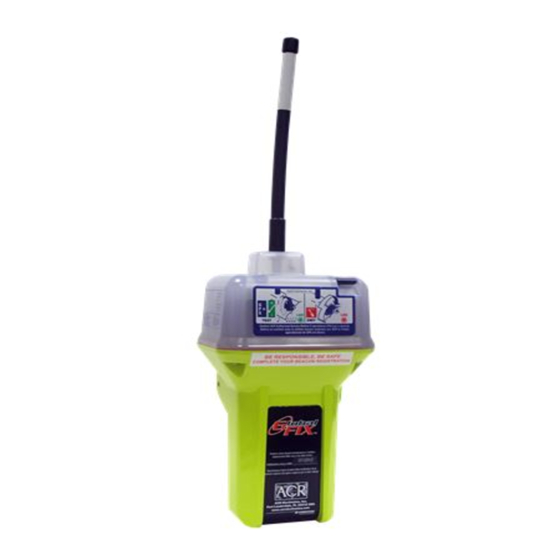- ページ 6
アクセサリー ACR Electronics 406 EPIRB, NOAAのPDF 製品サポートマニュアルをオンラインで閲覧またはダウンロードできます。ACR Electronics 406 EPIRB, NOAA 16 ページ。 Emergency position indicating radio beacon
ACR Electronics 406 EPIRB, NOAA にも: マニュアル (2 ページ)

SECTION 3 - INSTALLATION
3.1
Mounting Location
The location selected must be sufficiently rigid to support the weight of the total installation and at the same
time consider vibration, exposure to the elements, exposure to surrounding hazards, such as equipment
movement, doors being opened, accidental covering, personnel traffic, etc., and yet be readily accessible at all
times for the emergency use for which the beacon is intended.
Also to be considered in selecting a location for installation is the harmful effect that certain corrosive vapors
might have on the beacon. Under no circumstances should a location be selected for installation where the
beacon would be jeopardized by any foreign articles being temporarily or permanently positioned during "at
sea" or "in port" activities.
Beacon should face inboard on rail mount applications and should not be subjected to breaking waves.
CAUTION: Care must be taken to prevent any lanyard, line, or other emergency equipment that may be
attached to the beacon from becoming entangled or fouled which could prevent the beacon from being
removed in an emergency.
Do not mount the beacon in the vicinity (3.3 ft/1 m) of strong magnetic (such as loud speakers) or electrical
(such as radar or high power radio transmitter) fields. The beacon should not be mounted closer than 3.3 ft. to
a navigation compass.
Consideration should be given to mounting the beacon in a vertical (antenna upward) position. In certain
circumstances, such as medical emergencies or disabled vessels, manual activation of the EPIRB for location
and homing purposes is sometimes requested. Mounting in this orientation provides the best homing signal.
The GlobalFix™ (Product No. 2742) Cat. 1 float-free mounting bracket should be mounted securely to a
vertical or horizontal surface (the mount has predrilled holes for attachment to a flat surface) where there are
no overhead obstructions. Location aboard a vessel must be chosen to allow the EPIRB to float free of sinking
craft and as high as possible, especially on small vessels. This will help ensure operation of the hydrostatic
release unit in the event the vessel capsizes without sinking. See Section 5.2 on removing the HRU.
The GlobalFix™ (Product No. 2742) Cat. 1 float-free mounting bracket should be securely attached to the
vessel. The use of #10 stainless steel hardware is recommended.
3.2
Visual Inspection
Visually inspect the area surrounding the mounting bracket installation site for hidden hazards, obstacles, etc.,
that may have been overlooked during selection. If there is any doubt as to the ready accessibility to the
beacon at all times or if any condition may appear to be questionable, make a complete and thorough
investigation before making final approval of the installation.
Hydrostatic Release Dating Instruction (Product No. 2742) Cat. 1.
3.3
The label on the hydrostatic release mechanism inside of the bracket and the replacement date label on the
outside of the bracket MUST be scratched with the date of expiration at time of installation according to coastal
marine authority regulations.
To record the expiration date on the hydrostatic release mechanism, scratch the date on the label to indicate
the month and year two years from date of installation. Write the date of expiration with an indelible marker on
the outside cover.
3
Y1-03-0157 Rev. F
